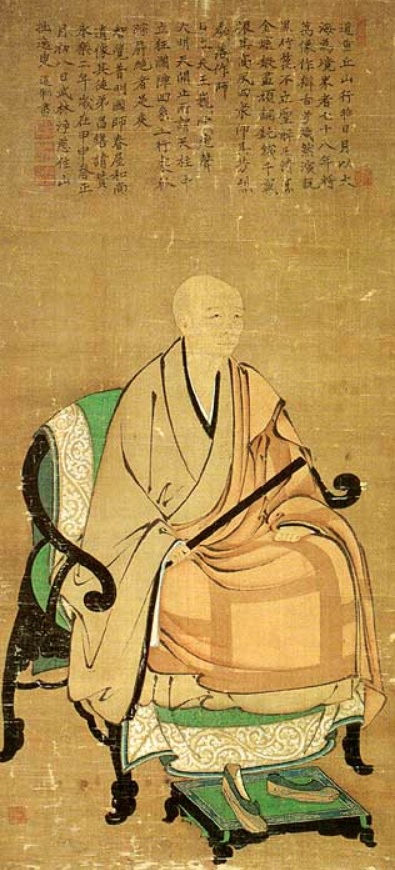ZEN MESTEREK ZEN MASTERS
« Zen főoldal
« vissza a Terebess Online nyitólapjára

春屋妙葩 Shun'oku Myōha (1312–1388)
https://ja.wikipedia.org/wiki/%E6%98%A5%E5%B1%8B%E5%A6%99%E8%91%A9

https://www.metmuseum.org/art/collection/search/59669
春屋妙葩像 自賛 Portrait of Shun'oku Myōha, ca. 1383
Hanging scroll; ink, color, and gold on silk,
115.9 × 52.1 cm
Unidentified Artist
The Zen priest Shun'oku Myōha (1311–1388) is shown seated cross-legged in a red lacquer chair with his shoes placed on a footrest. Shun'oku's illustrious monastic career included top administrative positions, abbotships at major monasteries, and close relationships with the first and third Ashikaga shoguns. Zen portraits of this type, called chinsō, were disseminated among followers and served a ritual function in funerals and memorial services. The bamboo staff signifies authority, and Shun'oku's decorative robes and kesa (monk's vestment) are important signs of rank. Shun'oku inscribed his portrait with a poem:
There are no eyes atop the head.
There are eyebrows below the chin.
This is everything; this is nothing.
I also could not become a phoenix.
Inscribed by Myōha of Tenryū[ji] for [?] at Muryōjuin
—trans. Anne Nishimura Morse and Samuel Morse

https://blogs.yahoo.co.jp/monmoblog/2032391.html
春屋妙葩頂相
室町時代 縦117.0 横55.0
吉山明兆筆 祖芳道聯賛
絹本着色 光源院蔵
本図は春屋の聡明さと世事にも秀でた手腕家としての一面をうかがわせるもので、左下隅に「破草鞋」印が捺され、肖像画、人物画に優れた明兆の手になることを示している。強弱を持つ鋭い墨の衣紋線が特徴的で、全体の色調が地味であり、水墨画的な趣致をみせ、通常の頂相とはやや趣を異にしている。図上の長文の賛は杭州の浄慈寺住持、祖芳道聯(ソホウドウレン)が春屋の徒弟昌善のために記したもので、永楽2年は応永11年(1104)、春屋の寂後17年目に当たる。